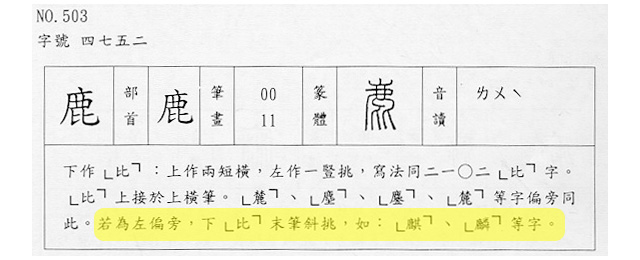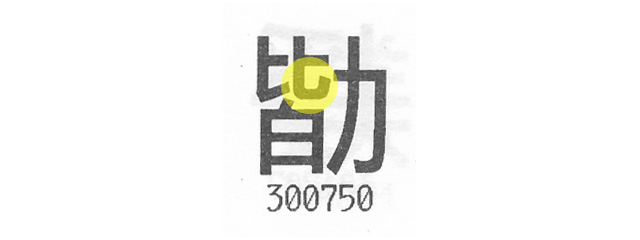
Shown above is the top portion of the printed version of Taiwan’s MOE 國字標準字體方體母稿 (Fangti) standard. (For those who are interested, its ISBN is 957-00-8392-1.) What is provided online are effectively scans of the 常用字 and 次常用字 sections, which contain 4,808 and 6,343 hanzi, respectively. Although included in the printed version of the standard, the 罕用字 section, which contains 1,907 additional hanzi, is not provided online. In terms of sheer numbers, these 1,907 additional hanzi appear to completely cover Big Five (both levels) and CNS 11643 Planes 1 and 2.
The purpose of today’s article is to describe two additional issues in this glyph standard that my new friend, Kuang-che Wu (吳光哲) of Google, recently found.
The first issue is that the glyph with index 201483, which corresponds to U+657B (敻; CNS 11643 Plane 2 0x5067), has the wrong style of Radical #66 (攵), specifically that its upper-right corner is a corner and not two separate strokes. The relevant portion is highlighted below:

The correct form of 201483 can be found in the appropriate pages of the Songti and Kaishu standards.
The second issue is that the glyph with index 206123 (U+9D9B; 鶛; CNS 11643 Plane 2 0x6B2E) has an incorrect form of the right side of the 比 component. Below is an excerpt that includes, for the sake of comparison, the glyph with index 205183 (U+911C; 鄜; CNS 11643 Plane 2 0x4E51) on the right that, interestingly enough, correctly uses this form of the 比 component according to the writing rules:

The highlighted text below is the specific writing rule that governs the glyph with index 205183:

The 罕用字 section of the same standard shows the correct form in the glyph with index number 300750 (U+52D3; 勓; CNS 11643 Plane 2 0x3371), shown below:

The correct form of 206123 can be found in the appropriate pages of the Songti and Kaishu standards.
Of course, these errors are being reported to Taiwan’s MOE.
The lesson to be learned here is that standards may have errors. Standards, especially those with a large amount of data, are prone to include errors. That is simply the nature of standards. While we trust standards to provide reliable information, we must also recognize when there are errors in the standard. The best course of action is to not propagate the error, and to report it to the appropriate standards body.

Kuang-che received the following reply from the Taiwan MOE that confirms these two errors, along with the error that is described in the previous article: